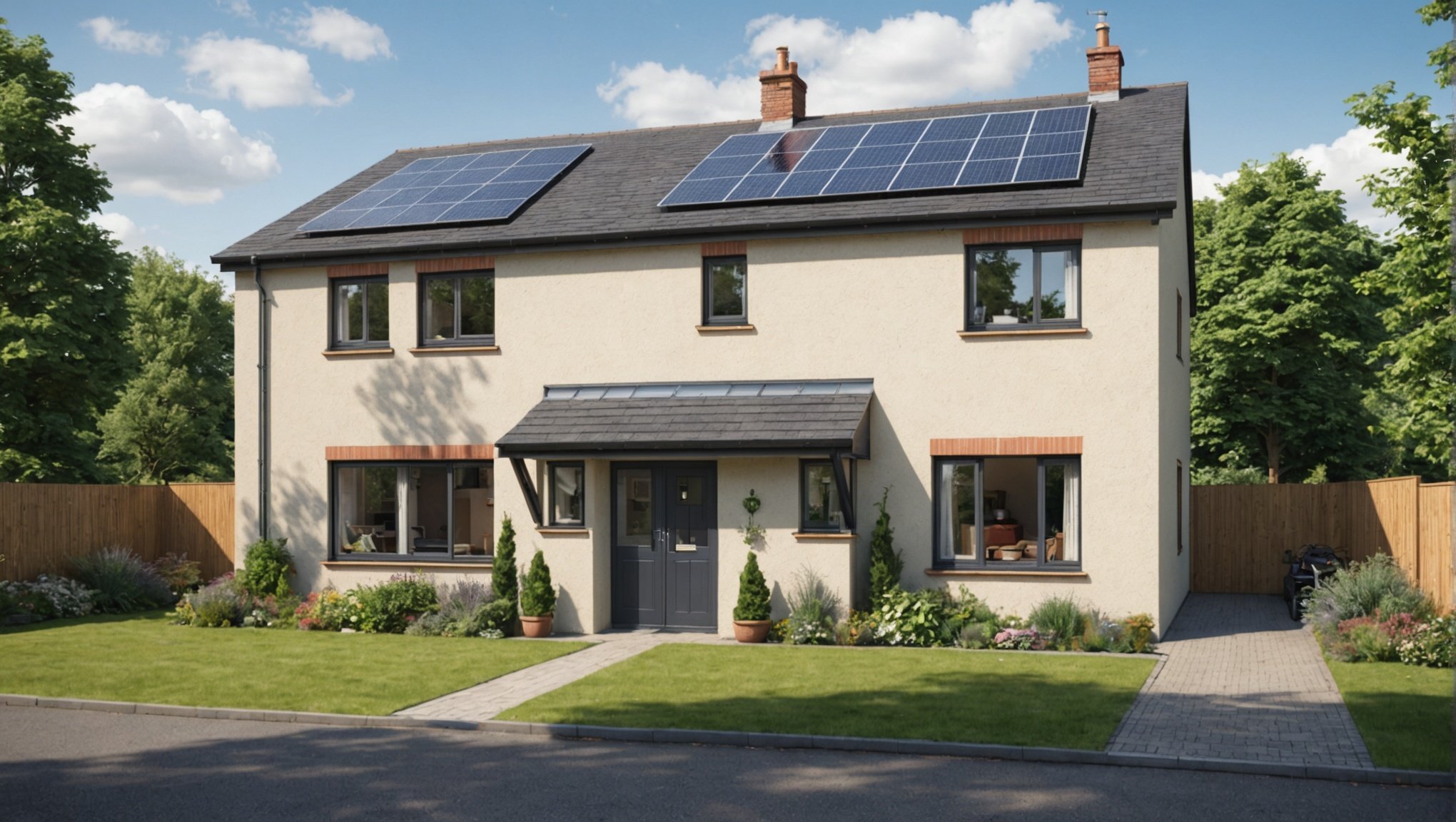Overcoming Obstacles: The Quest for Zero-Carbon Homes in Northern UK Regions
The Urgent Need for Sustainable Housing
As the world grapples with the daunting challenges of climate change, the built environment has emerged as a critical sector in the quest for sustainability. In the Northern UK regions, where harsh weather conditions and aging infrastructure pose unique challenges, the push for zero-carbon homes is not just a trend, but a necessity.
The UK government has set ambitious targets to achieve net-zero carbon emissions by 2050, and the housing sector is at the forefront of this effort. Developers like Newland Homes and Esh Construction are leading the charge, introducing innovative designs and construction methods that prioritize energy efficiency and sustainability.
In parallel : Essential Guide to Conducting Environmental Impact Assessments for Real Estate Projects in the UK: Key Steps Explained
Innovative Designs and Technologies
One of the key strategies in building zero-carbon homes is the integration of sustainable design principles from the outset. Newland Homes, for instance, has introduced brand new house designs that are not only stylish and comfortable but also highly energy-efficient. Their approach includes the use of advanced materials, passive house techniques, and renewable energy systems such as solar panels and heat pumps[1].
In Middlesbrough, Esh Construction is developing 10 net-zero carbon homes for the Thirteen Group, a housing association. These homes are designed with cutting-edge technologies to minimize carbon emissions. Here are some of the innovative features being implemented:
Also to see : Unlocking Savings: The Financial Advantages of Embracing Green Building Standards in Urban Development
- Advanced Insulation: High-performance insulation to reduce heat loss and energy consumption.
- Renewable Energy Systems: Solar panels and wind turbines to generate electricity.
- Energy-Efficient Heating: Heat pumps and biomass boilers to provide sustainable heating solutions.
- Smart Home Technologies: Integrated systems to monitor and optimize energy usage in real-time[5].
Overcoming Challenges in the North
Building zero-carbon homes in Northern UK regions comes with its own set of challenges. Here are some of the obstacles and how they are being addressed:
Harsh Weather Conditions
The North of the UK is known for its cold and wet climate, which can significantly impact the energy efficiency of homes. To combat this, developers are using robust and weather-resistant materials. For example, Esh Construction’s net-zero homes in Middlesbrough are built with durable materials that can withstand the local climate while maintaining high levels of insulation[5].
Existing Infrastructure
Many areas in the North have aging infrastructure that can make it difficult to implement new sustainable technologies. However, this is being addressed through collaborative efforts between developers, local authorities, and utility companies. For instance, the development project in Teesside involves a comprehensive upgrade of the local infrastructure to support the integration of renewable energy systems[3].
Cost and Affordability
One of the significant challenges is the higher upfront cost of building zero-carbon homes. To make these homes more affordable, developers are exploring various funding options and government incentives. For example, Livv Housing is benefiting from funding for regeneration, which includes building new zero-carbon homes. This funding helps offset the initial costs, making sustainable housing more accessible to a wider audience[4].
Case Study: Newland Homes’ Zero-Carbon Development
Newland Homes’ development in Claverham is a prime example of how zero-carbon homes can be successfully integrated into existing communities. Here are some key aspects of this project:
Community Engagement
Newland Homes has engaged extensively with the local community, including school children, to raise awareness about the benefits of zero-carbon homes. This engagement not only educates the community but also fosters a sense of ownership and pride in sustainable living[1].
Carbon Offset and Reduction
Newland Homes has calculated and offset its carbon emissions with Carbon Neutral Britain. This commitment to carbon reduction is reflected in their building practices, which include the use of low and zero-carbon materials and energy-efficient systems[1].
Economic Benefits
The development has also highlighted the economic benefits of sustainable housing. By reducing energy costs through efficient design and renewable energy systems, homeowners can save significantly on their energy bills. This not only makes sustainable living more affordable but also contributes to the local economy by reducing the financial burden on households[1].
Practical Insights and Actionable Advice
For those interested in transitioning to zero-carbon homes, here are some practical insights and actionable advice:
Conduct an Energy Audit
Before making any changes, conduct a thorough energy audit of your home to identify areas of energy inefficiency. This will help you prioritize improvements and make the most of your investment.
Invest in Renewable Energy
Consider installing renewable energy systems such as solar panels or wind turbines. These can significantly reduce your reliance on fossil fuels and lower your carbon emissions.
Improve Insulation
Ensure your home is well-insulated to reduce heat loss and energy consumption. This can include upgrading your windows, adding insulation to your loft and walls, and sealing any gaps or drafts.
Engage with Local Initiatives
Look into local initiatives and government incentives that support sustainable housing. Many regions offer grants, subsidies, or tax credits for homeowners who invest in energy-efficient upgrades.
The Role of Research and Network in Sustainable Development
Research and networking play crucial roles in the development of zero-carbon homes. Here’s how these elements are contributing to the cause:
University Collaborations
Universities are at the forefront of research in sustainable building technologies. Collaborations between developers and academic institutions can lead to the development of new materials, designs, and systems that enhance energy efficiency and reduce carbon emissions.
Industry Webinars and Workshops
Regular webinars and workshops organized by industry leaders and associations help disseminate best practices and new technologies. These events provide a platform for developers, architects, and policymakers to share knowledge and address common challenges.
Supply Chain Management
Effective supply chain management is essential for ensuring that materials used in construction are sustainable and have a low carbon footprint. Developers are working closely with suppliers to source materials that meet high sustainability standards.
Table: Comparison of Zero-Carbon Home Projects in Northern UK
| Project | Location | Developer | Number of Homes | Key Features |
|---|---|---|---|---|
| Newland Homes Development | Claverham | Newland Homes | 24 | Zero-carbon specification, renewable energy systems, advanced insulation[1] |
| Esh Construction Project | Middlesbrough | Esh Construction | 10 | Net-zero carbon homes, smart home technologies, energy-efficient heating[5] |
| Thirteen Group Development | Teesside | Esh Construction | 10 | Net-zero carbon homes, upgraded infrastructure, renewable energy integration[3] |
Green Jobs and Sustainable Development
The push for zero-carbon homes is not only about reducing carbon emissions but also about creating green jobs and contributing to sustainable development. Here’s how this is happening:
Job Creation
The construction of zero-carbon homes requires specialized skills and labor, leading to the creation of green jobs in the sector. From solar panel installers to energy auditors, these jobs are crucial for the transition to a sustainable built environment.
Economic Growth
Sustainable housing projects can stimulate local economies by creating demand for sustainable materials and services. This can lead to economic growth and development in regions that might otherwise be lagging behind.
The journey to achieving zero-carbon homes in Northern UK regions is fraught with challenges, but it is also filled with opportunities. Through innovative designs, technological advancements, and collaborative efforts, developers are overcoming obstacles and setting new standards for sustainable housing.
As Jeremy Drew, Director of Newland Homes, aptly puts it, “Being Climate Considerate means acting on your beliefs and not just talking about them. There is nothing more rewarding than seeing our vision for a sustainable future emerging through our news stories”[1].
The future of housing is sustainable, and the North is leading the way. By embracing these changes and supporting initiatives that promote zero-carbon homes, we can create a warmer, greener, and more sustainable future for all.











